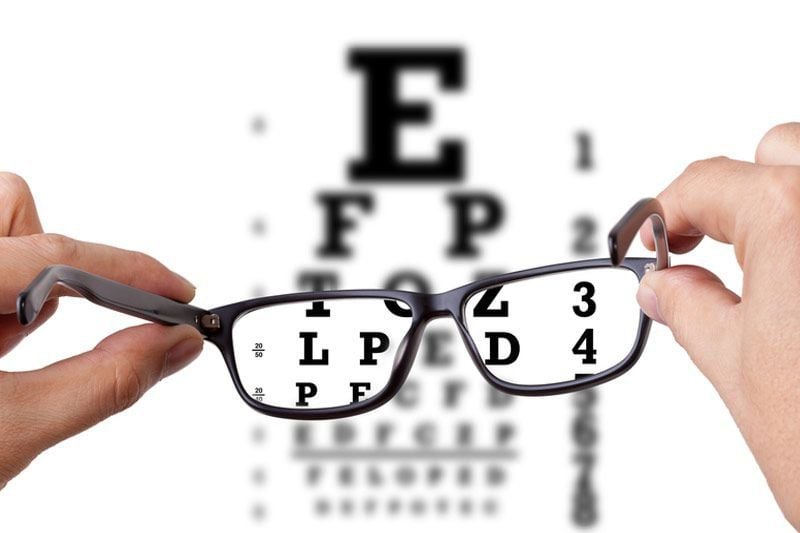1/ What is mild astigmatism?
Astigmatism is considered mild when the diopter measurement is under 1.0 D. Yet even at just 0.25 D or 0.5 D, patients may experience visual issues such as slight blur, distorted vision, night vision problems, headaches, and eye strain during prolonged reading or screen use.

Night driving vision affected by mild astigmatism.
This happens because the cornea is irregularly curved, preventing light from focusing at a single point on the retina. As a result, images may appear distorted or blurry, even when daytime vision seems adequate. Early signs can be subtle, often overlooked, but may cause chronic discomfort if left untreated.
2/ Commonly overlooked symptoms of mild astigmatism
- Blurred vision when reading or working on a screen
- Squinting or tilting the head when trying to see clearly at a distance
- Eye fatigue and headaches, especially in the evening
- Sensitivity to lights or seeing halos while driving at night
Comparison: Normal vision vs. mild astigmatism
| Criterion | Normal Eyes | Mild Astigmatism |
|---|---|---|
| Image clarity | Sharp both near and far | Blurry or difficult to see fine details |
| Eye strain rate | Rarely experience strain during reading/work | Frequent fatigue, especially later in the day |
| Night vision | Clear and comfortable | Glare, halos, and poor contrast |
Quick guide: When should glasses be worn for mild astigmatism?
| Condition | Glasses needed? | Reason |
|---|---|---|
| Astigmatism 0.25 D | Case-dependent | Advised if symptoms like eye strain or headaches occur |
| Astigmatism 0.5 D | Recommended | Improves image clarity, reduces accommodative effort |
| Astigmatism ≥ 0.75 D | Mandatory | Prevents visual misalignment and chronic fatigue |
3/ Why should mild astigmatism be corrected?
Even when not severely blurring vision, mild astigmatism forces the eyes to constantly adjust focus. Over time, this leads to chronic fatigue, accommodative dysfunction, and a sense of visual confusion.
Corrective lenses guide light to focus directly on the macula, restoring clarity and reducing strain. For children, failing to correct even mild astigmatism may cause amblyopia (lazy eye), or impair reading and learning abilities long term.
In adults, mild astigmatism often goes undiagnosed due to vague symptoms like fatigue or poor concentration—leading to delays in treatment.
4/ Advanced diagnostics: A path to visual comfort
At TD Eye, even mild astigmatism is evaluated using:
- Automated multi-axis refraction
- Corneal topography and ocular surface mapping
- Detailed accommodative and gaze assessment
- Night vision evaluation to detect hidden astigmatism
Additionally, we analyze internal ocular aberrations (HOAs) that cannot be corrected with standard glasses. This allows for tailored lens prescriptions or surgical recommendations.
5/ Treatment Options Available at TD Eye

Toric contact lenses – a popular solution for those with mild astigmatism due to aesthetic appeal, lightweight nature, and clarity at all angles
- Properly aligned cylindrical eyeglasses that correct axis deviation – especially crucial for individuals who spend extended hours in front of screens or are under intensive academic demands.
- Specialized contact lenses with custom optics – suitable for patients with high-order aberrations (HOAs) or irregular refractive errors.
- Phakic ICL surgery to correct astigmatism from 1.0 to 4.0 D – ideal for patients with poor night vision, visual hypersensitivity, or those who cannot tolerate glasses due to allergies, off-axis issues, or demanding sports activities.
Note: Phakic ICL does not harm the cornea, does not involve cutting, and does not cause dry eyes – making it a safe and advanced option for young patients with high visual demands, sensitive eyes, or thin corneas. Moreover, because Phakic ICL is removable and preserves the natural eye structure, it’s an excellent long-term solution with the flexibility for future adjustments.
At TD Eye, treatment is highly personalized. Every patient’s condition is evaluated holistically through corneal topography, axial length measurement, and ocular surface assessment. This ensures the right corrective method is chosen based on not only the degree of astigmatism but also patient lifestyle, occupational needs, and long-term visual health.
6/ Conclusion
Mild astigmatism may seem harmless, but it can still affect your visual comfort and daily performance if left uncorrected. Wearing the right glasses and having regular eye exams are essential to maintain clear vision and reduce eye strain.
With modern diagnostics and treatments like Phakic ICL at TD Eye, you can achieve optimal vision even with low-level astigmatism—without compromising comfort or lifestyle.

 vi
vi 26-Jul-2025
26-Jul-2025












 0916.741.763
0916.741.763 Appointment
Appointment